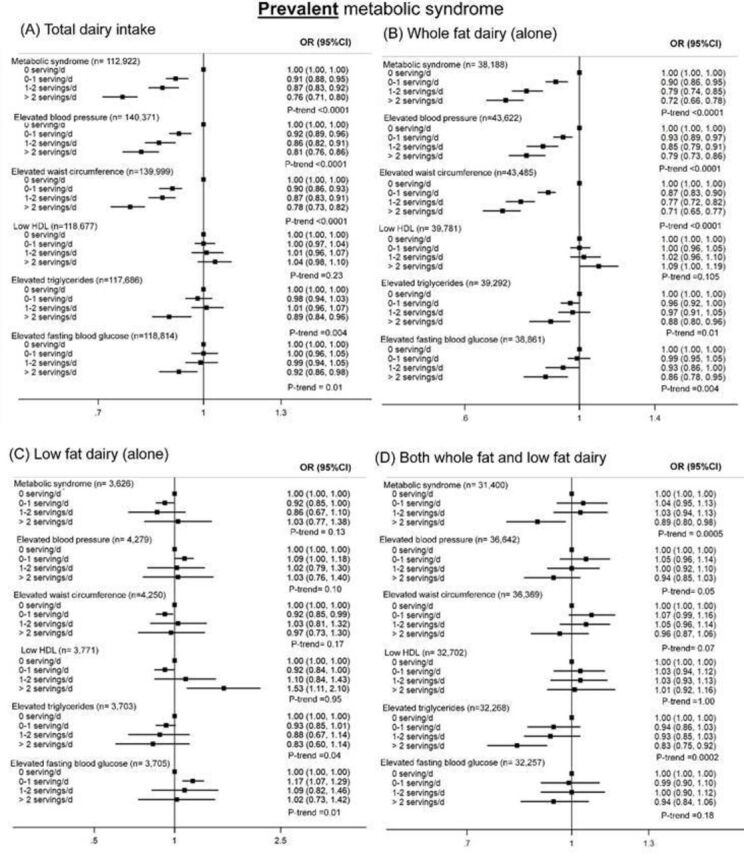Figure 1.

Association of (A) total dairy, (B) whole fat dairy alone, (C) low fat dairy alone and (D) among those who consumed both whole fat and low fat dairy with prevalent metabolic syndrome and its component (OR, 95% CI). Metabolic syndrome: defined as presence of any three of the four components: elevated blood pressure (defined as those on blood pressure lowering medication, or systolic blood pressure) ≥130 mm Hg or diastolic blood pressure (DBP) ≥85 mm Hg); elevated waist circumference (defined as women with waist >80 cm, men with waist ≥94 cm, except among Asians or South Americans in whom waist was ≥90 cm), reduced high density lipoprotein cholesterol (HDL-C) (defined as men on cholesterol lowering medications or with HDL-C<1 mmol/dL (40 mg/dL), or women with HDL-C<1.3 mmol/L (50 mg/dL)); elevated triglycerides (defined as triglyceride levels>1.7 mmmol/dL (150 mg/dL)); and elevated fasting blood glucose (defined as as those on glucose lowering medications or with a fasting glucose value ≥5.5 mmol/L). OR models for metabolic syndrome and waist circumference are adjusted for age (continuous), sex, smoking status, education, location, physical activity, energy intake, percent energy from carbohydrate, fruit and vegetable intake, and study center as random effect. Models for whole dairy intake are adjusted for low fat dairy intake and vice versa. OR model for elevated blood pressure, low HDL-C, elevated triglycerides and elevated fasting blood glucose are adjusted for age (continuous), sex, body mass index (continuous), smoking status, location, education, physical activity, energy intake, quintiles of percent energy from carbohydrate, fruit and vegetable intake, and study center as random effect. Models for whole dairy intake are adjusted for low fat dairy intake and vice versa. Panel (A) shows a significant inverse association between total dairy intake and metabolic syndrome and each of its components, except low HDL-C (no association); (B) shows a significant inverse association between whole fat dairy (alone) intake and metabolic syndrome, elevated blood pressure, elevated waist circumference, elevated triglycerides, and elevated fasting blood glucose. No association was observed between whole fat dairy and low HDL-C; (C) shows no association between low fat dairy (alone) intake and metabolic syndrome and its components, except elevated triglycerides and elevated fasting blood glucose (a trend towards lower prevalence); and (D) shows a significant inverse association between consumption of both whole fat and low fat dairy and metabolic syndrome, elevated blood pressure and elevated triglycerides, and no association with elevated waist circumference or HDL-C or elevated fasting blood glucose.
